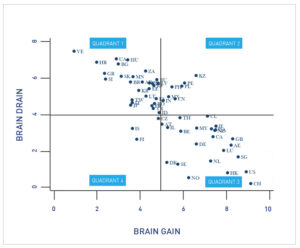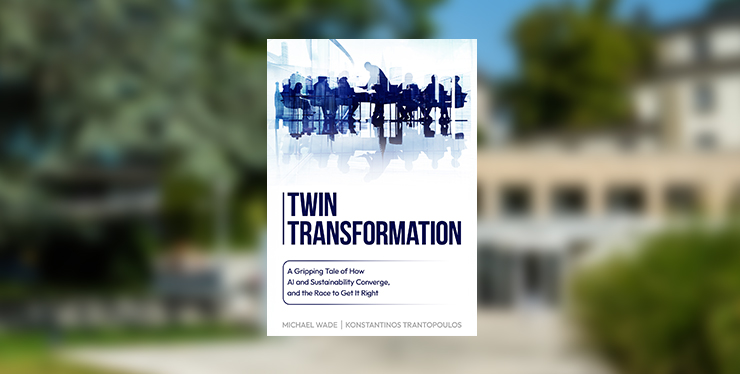
What drives brain drain and brain gain?
Based on the extensive data and survey results gathered by the IMD World Competitiveness Yearbook (taken from the years 2000-2016), The IMD World Talent Ranking assesses the ability of 63 countries to develop, attract and retain talent for enterprises operating in those economies.
Brain drain and brain gain can be key factors determining the level of competitiveness and talent attractiveness of a country. On the occasion of the release of this year’s World Talent Ranking we took an in-depth look at brain drain and gain, and tried to understand what the main drivers of these phenomena are. First, let’s look at which countries are the most affected. Among the most negatively impacted are Croatia (HR), Greece (GR), Bulgaria (BG) and Brazil (BR). They experience high levels of brain drain without in turn attracting foreign talent (i.e., low brain gain). Mexico (MX), China (CN), India (IN) and the Philippines (PH), show somewhat high levels of brain drain but they are able to remain relatively attractive to expat professionals. Meanwhile Norway (NO), the Netherlands (NL), Canada (CA) and Singapore (SG) have lower levels of brain drain and higher levels of brain gain (quadrant 3). Finally, Iceland (IS), Finland (FI), and to a lesser extend the Czech Republic (CZ), experience lower levels of brain drain while experiencing high levels of brain gain (quadrant 4).See graph 1 for more country specific details:
Graph 1. Global Distribution of talent 2016

What indicators play a key role in determining talent flows? What factors give a “talent competitive advantage” to a particular country?
From the overall results of our research, it becomes clear that there is a set of key factors driving talent flows. The main areas that affect brain drain and gain are as follows:
- Legislation – Legislation that effectively promotes scientific research, non-restrictive immigration laws, and a lower risk of political instability, all decrease brain drain. This suggests that more open and forward-looking societies better prevent domestic talent from leaving the country.
- Agility – The agility and adaptability of companies to market changes as well as inclusive corporate values also reduce brain drain. The agility exhibited by companies may be perceived of as trait of innovation thus attracting overseas talent while also encouraging locals to remain in their home country.
- Education – The quality of an education system is an important factor in increasing the inflow of overseas talent, or brain gain. This may be an indication that highly skilled staff consider the quality of schools for their children when making a decision whether or not to relocate. In addition, quality of education, particularly at university level, may entice local talent to remain in their country by reducing the need to search for a better education elsewhere. On the other hand, attending university overseas is likely to lead to permanent relocation increasing the brain drain experience by an economy.
- Health – A country’s health infrastructure is a significant determinant of talent attractiveness. This may be the case because a workforce that enjoys overall healthy lives tends to remain in their country of origin thus reducing the need to attract foreign personnel.
- Pay – Relatively speaking, remuneration levels appear to have only a marginal impact on the attractiveness of countries to foreign talent. The quality of the education system in a country is, for instance, of greater significance at determining talent flows.
- Motivation – Worker motivation is a key factor in reducing brain drain, it also contributes to increasing brain gain. It sends a strong signal to overseas talent that, for example, firms in a particular country offer a work environment highly conducive to maintaining strong employee morale.
To improve their talent competitive advantage, countries should adopt a three-pronged approach. Institutionally, governments should focus on the furthering of regulation that encourages scientific development, openness (particularly to foreign labor) and strengthens political stability. The private sector should further adopt strategies that increase the flexibility of enterprises to adapt to changes thereby bolstering a culture of innovation. In addition, business strategies should advance a work environment that increases job satisfaction so as to boost the motivation of staff. Academically, it is important to strengthen the role of education in targeting talent flows. To this end, increasing the quality of the system is paramount. Furthermore, the adaptability of school curricula is vital in facilitating the development of particular skills and competencies necessary to meet specific talent needs of the economy. This approach can invigorate talent-related factors which our research results show to be significant “traits” to attract and retain local and overseas talent.
To be sure, our research does not capture some country-specific characteristics which may undoubtedly affect talent flows, such as language, geographical location, climate and historical legacies. There are obvious barriers to talent attraction, for example, when a country’s language is spoken by too few people, or when the country is geographically remote from areas where population tends to concentrate (e.g., Iceland). To the extent that such factors cannot be managed in the short/middle term, we have not taken them into account in this study.
Find out more about the IMD World Talent Ranking 2017.
Arturo Bris is Professor of Finance at IMD and directs the IMD World Competitiveness Center.
Shlomo Ben-Hur is Professor of Leadership, Talent Management and Corporate Learning at IMD where he directs the Organizational Learning in Action (OLA) and the Cultivating Leadership Energy through Awareness and Reflection (CLEAR) programs.
José Caballero is Senior Economist at the IMD World Competitiveness Center.
Research Information & Knowledge Hub for additional information on IMD publications
To understand America’s aggressive shift on trade, you must first grasp the silent, slow building, decades-long erosion of American middle-class prosperity. This shift began well before President Trump and will outlive him. It is rooted in the col...
Despite geopolitical upheavals that threaten global growth, companies continue to see business opportunities across borders. As leaders strategize how to position their operations amid war, trade disputes, disease outbreaks, and climate change, ha...
The Great Trade Hack by Richard Baldwin explains how Trump’s 2025 tariff blitz wasn’t economic strategy. It was grievance politics. Tariffs, Baldwin shows, are political placebos that won’t fix the U.S. economy but could fracture the global trade ...
in I by IMD
Research Information & Knowledge Hub for additional information on IMD publications
in I by IMD
Research Information & Knowledge Hub for additional information on IMD publications
in Gensler, Gary (Ed.); Johnson, Simon (Ed.); Panizza Ugo (Ed.); Weder di Mauro, Beatrice (Ed.) / The Economic Consequences of The Second Trump Administration: A Preliminary Assessment, pp. 239-244 / PAris: CEPR Press, 2025
Research Information & Knowledge Hub for additional information on IMD publications
in I by IMD
Research Information & Knowledge Hub for additional information on IMD publications
Published by International Institute for Management Development ©2025
Research Information & Knowledge Hub for additional information on IMD publications
Research Information & Knowledge Hub for additional information on IMD publications
in MIT Sloan Management Review Summer 2025, vol. 66, issue 4, pp. 38-43
Research Information & Knowledge Hub for additional information on IMD publications
in I by IMD
Research Information & Knowledge Hub for additional information on IMD publications
Research Information & Knowledge Hub for additional information on IMD publications
Research Information & Knowledge Hub for additional information on IMD publications







